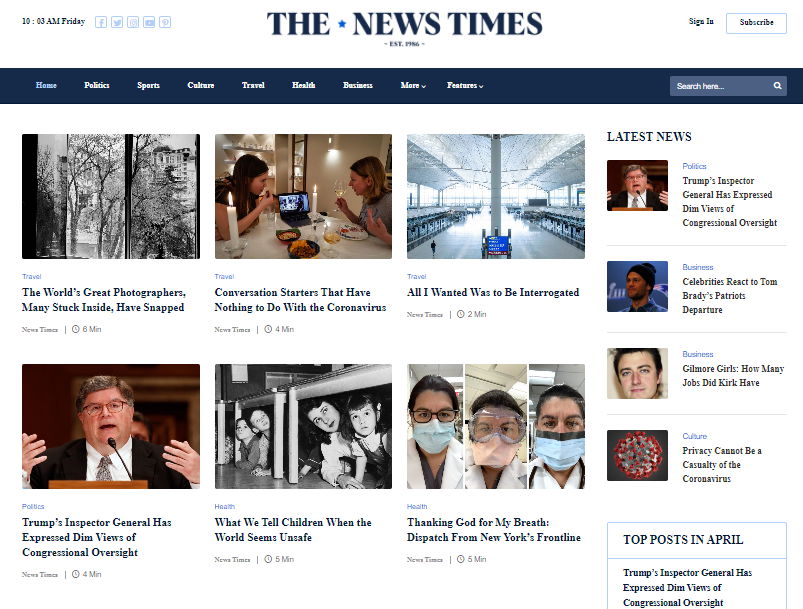The Impact of Social Network en route We Take In News Online
Social media site has actually basically changed news intake. It supplies instant accessibility to info, typically eclipsing standard media electrical outlets. This rapid circulation comes with challenges. Individuals encounter the risk of experiencing false information and ending up being trapped in echo chambers. The algorithms driving tailored material can cover diverse viewpoints. As these characteristics develop, recognizing their implications comes to be essential for educated engagement in public discourse. What approaches might assist navigate this facility landscape?
The Evolution of News Intake in the Digital Age
As technology progressed, the method individuals consumed news changed considerably in the electronic age (stnews.live). Conventional papers and relayed media started to decline as the net became a main resource of details. On the internet platforms offered instant accessibility to newspaper article, videos, and podcasts, allowing users to remain notified at any moment. The convenience of smart phones additionally accelerated this change, enabling users to get updates on the move
Additionally, the increase of news collectors and sites facilitated the usage of varied viewpoints, encouraging customers to customize their news consumption based on individual passions. This advancement also prompted news companies to adapt their strategies, concentrating on digital web content and appealing viewers via multimedia formats. Consequently, the conventional obstacles of time and area in news delivery reduced, causing a much more immediate and personalized news experience for audiences worldwide.
The Role of Social Media Platforms in News Distribution
Social network platforms have actually changed news distribution by supplying immediate accessibility to info. Their algorithm-driven web content curation frequently focuses on engagement over precision, bring about substantial integrity obstacles (stnews.live). As individuals browse this landscape, the ramifications for news usage and public discussion come to be significantly intricate
Instantaneous News Accessibility
Conventional news outlets have long been the main resource of information, the rise of social media platforms has considerably changed how news is accessed and taken in. Instantaneous news gain access to has actually become a characteristic of the electronic age, allowing users to receive updates in real time. Platforms such as Twitter, Facebook, and Instagram permit news to spread quickly, commonly exceeding conventional media in rate and reach. Individuals can share stories, discuss occasions, and engage with reporters, creating a vibrant interaction in between the audience and news material. This immediacy promotes a culture of necessity, prompting users to look for details swiftly. The expectation for prompt news has improved journalistic practices, compelling news companies to adapt their approaches to satisfy the demands of a fast-paced electronic setting.
Algorithm-Driven Material
While customers proactively involve with material on social networks, the formulas that regulate these systems play a pivotal function in determining which news stories obtain presence. These formulas evaluate individual habits, choices, and engagement metrics to curate customized news feeds. Therefore, specific tales might be magnified while others stay obscure, usually focusing on spectacular or trending topics over substantive coverage. This selective exposure shapes customers' understandings of present occasions and affects public discourse. The reliance on algorithm-driven content can produce echo chambers, where users are mainly subjected to viewpoints that straighten with their very own ideas. Subsequently, the dynamics of news circulation on social networks platforms greatly impact just how people eat and translate info in the electronic age.

Integrity Challenges
As individuals progressively turn to social networks for news, the reliability of info come across on these platforms ends up being a pushing worry. The decentralized nature of social media allows anybody to release content, often blurring the lines in between trustworthy journalism and false information. Formulas prioritize involvement over precision, resulting in the widespread dissemination of sensational or deceptive tales. This atmosphere positions considerable challenges for individuals trying to recognize reliable resources. Social media systems, while venturing to fight misinformation via fact-checking and material moderation, run the gauntlet for inconsistencies and prejudices in their approaches. Ultimately, the obligation lies with customers to seriously assess the news they eat, as the rapid spread of information usually outmatches verification efforts by platforms.
The Rise of Person Journalism and User-Generated Web Content
The surge of person journalism has actually encouraged day-to-day people to share news and point of views, commonly providing insights that typical media might forget. However, this change likewise presents considerable obstacles, specifically the spread of misinformation that can emerge from unproven content. As user-generated material comes to be much more common, the balance between genuine voices and precision in reporting stays a vital problem.
Empowering Day-to-day Voices

Challenges of Misinformation
While the increase of person journalism has actually opened up methods for diverse voices in the media landscape, it has actually likewise presented significant difficulties associated to false information. The convenience of sharing information with social networks systems permits people to share news promptly, but this rapid spread usually comes with the cost of accuracy. User-generated web content often lacks the rigorous fact-checking and content oversight a fantastic read that standard journalism provides. As a result, sensationalized or incorrect stories can gain grip, misdirecting target markets and shaping public perception (stnews.live). In addition, the blending of point of view and fact within social media complicates the distinction in between legitimate details and misinformation. Therefore, customers need to browse an increasingly complicated media atmosphere, calling for crucial thinking skills to recognize trusted news resources in the middle of the sound

Misinformation and Its Effects for Public Discourse
As social networks platforms progressively control the landscape of info dissemination, the proliferation of false information poses significant obstacles for public discourse. Misinformation, frequently made to deceive or prompt psychological actions, can misshape perceptions of fact and weaken trust fund in credible resources. This sensation causes polarized perspectives, as people are attracted in the direction of echo chambers that enhance their ideas, additionally lodging divisions within society.
The ramifications for public discussion are extensive. When people rely upon incorrect information, significant dialogue reduces, and the autonomous process experiences. False information can incite anxiety and complication, affecting public wellness, safety, and political security. Consequently, cultivating media proficiency becomes crucial, encouraging individuals to critically examine details and recognize fact from fiction. Addressing the obstacles presented by false information is essential for protecting the honesty of public discourse and ensuring an educated population efficient in participating in constructive discussions.
The Influence of Algorithms on News Presence
Provided the main function of formulas in identifying material exposure, their influence on news consumption is profound. These formulas, used by social media sites systems, prioritize specific kinds of content based on customer involvement and preferences. As a result, news write-ups that line up with preferred patterns or target market rate of interests are most likely to This Site be shown prominently, while less mind-blowing stories may be overlooked. This creates a setting where users are subjected mainly to info that enhances their perspectives, potentially bring about echo chambers.
In addition, the constant advancement of formulas suggests that news organizations must adjust their methods to straighten with these transforming specifications, often prioritizing clickbait or emotionally charged headings. Consequently, the integrity of news coverage can be jeopardized, as essential tales might not receive the presence they should have. The mathematical shaping of news exposure as a result plays a crucial function in influencing public understanding and understanding of existing events.
The Change Toward Aesthetic Narration in News Media
Increasingly, news media is welcoming visual narration as a powerful tool to involve target markets. This technique leverages photos, video clips, infographics, and interactive aspects to share details better than typical text-based layouts. As focus spans reduce, visuals supply a quick, impactful method to connect complicated tales and get customers' interest.
Platforms like Instagram and TikTok have further increased this fad, engaging news organizations to adjust their web content approaches to fit these visually-driven settings. By integrating engaging visuals, news outlets can improve psychological connections and foster better understanding of topical issues.
Visual storytelling allows for even more varied narratives, showcasing several point of views via vibrant presentations. As audiences significantly take in news with mobile gadgets, the shift toward visuals not only satisfies customer preferences but additionally helps to damage down barriers to details accessibility. Eventually, this evolution mirrors a broader transformation in just how news is generated and eaten in the electronic age.
Future Trends: Browsing the Altering Landscape of News Usage
While the digital landscape remains to progress, news consumption is positioned for substantial change driven by arising modern technologies and altering target market behaviors. As fabricated knowledge and equipment understanding development, personalized news feeds will certainly come to be more widespread, allowing users to get material customized to their interests. This customization could lead to higher engagement but also increase concerns about echo chambers and false information.
Additionally, the rise of voice-activated tools and smart speakers will affect just how news is supplied, moving the focus from visual to acoustic layouts. This trend might encourage news organizations to embrace more concise and appealing audio content.

Often Asked Inquiries
Exactly How Do Social Media Communications Affect News Credibility?
Social network communications can substantially affect assumptions of news credibility. Involvement metrics, such as likes and shares, commonly shape target market trust fund, with prominent posts gaining viewed legitimacy, no matter the accuracy or reliability of the details offered.
What Duty Do Influencers Play in Shaping News Narratives?
Influencers greatly shape news stories by leveraging their platforms to enhance certain stories, commonly tailoring content to their target market. This can result in prejudiced perspectives, affecting public assumption and focusing on sensationalism over valid coverage.
How Can Users Identify Reliable News Sources on Social Media Site?
Individuals can recognize trustworthy news sources on social networks by checking the resource's trustworthiness, verifying truths via multiple outlets, evaluating the expertise of the web content, and acknowledging potential prejudices in reporting to guarantee accurate info.
What Effect Does Social Media Have on Typical Journalism Jobs?
Social media considerably impacts standard journalism work by altering income designs, reducing need for print media, and fostering competition from resident journalists. Numerous experts deal with task instability and should adapt to quickly altering media landscapes.
Exactly How Do Different Demographics Consume News on Social Network?
Different demographics exhibit varied preferences for news usage on social networks. Younger target markets prefer platforms like TikTok and Instagram for quick updates, while older individuals tend to favor Facebook and Twitter for extra extensive discussions and articles.